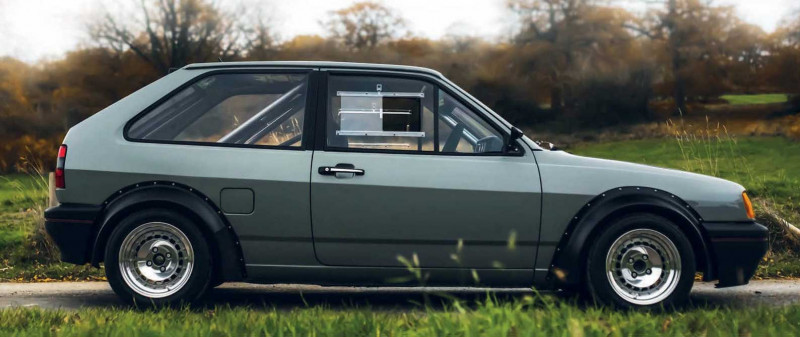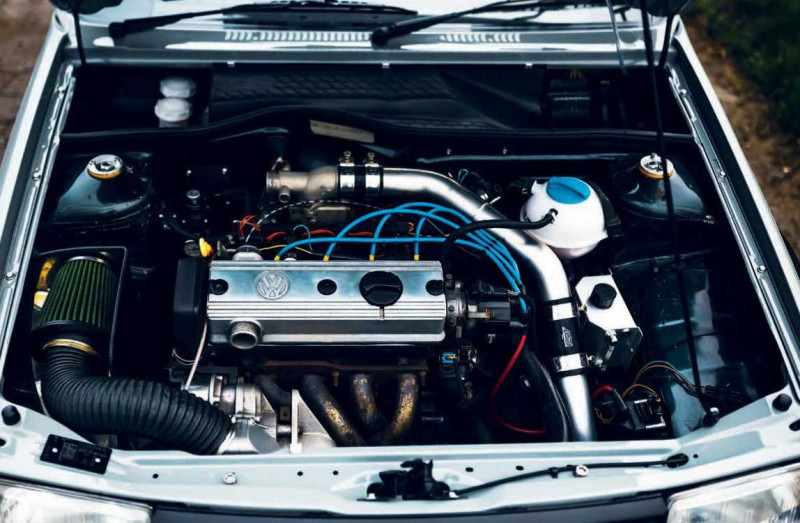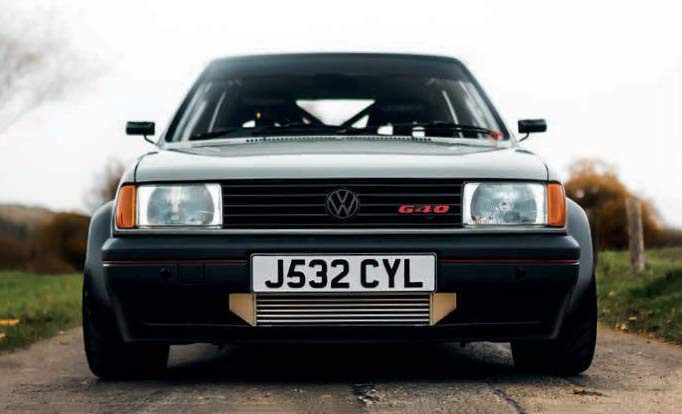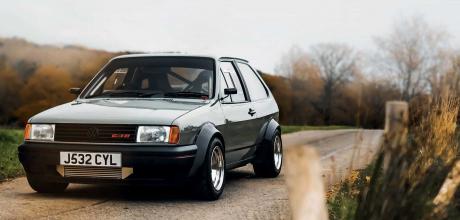1.3-litre supercharged 1992 Volkswagen Polo G40 Mk2F Typ 86C
From a quick turnaround track car project, Matthew Powney’s Polo G40 has evolved into an eight-year, ground-up restoration drawn from the quickest motorsport teams – and he’s not finished yet… Words: Alex Grant Photos: Mark Rodway.
AIN’ T NOTHING BUT A G THING, BABY!
Although it’s not as synonymous with its performance versions as the Golf, the Polo has quietly racked up a not-inconsiderable race history since it joined the range 46 years ago, and not just with private teams. The GT-G40 was a speed endurance record-holder in 1985, before Volkswagen Motorsport engineering gave it its own race series that lasted into the Nineties, and it didn’t stop there.

By 2000, the 6N2 16V was available as a factory-built junior rally car, and the Polo’s rallying career would progress through widearch S1600 and S2000 versions peaking with a competitive stint in the WRC and under later R5 regs. Plenty of inspiration to work with, if you know where to look.
You’d have had to look hard to take cues from this one, at least until recently. Going against the grain of painstakingly documented social media build threads, the eight-year re-work of Matthew Powney’s Polo G40 unfolded behind the digital curtain of a private Instagram account before breaking cover at the Retro Rides Gathering last year. It’s a street legal track and hill climb-ready machine, honed with all the advantages of long-held ideas – some of which go back much further than its last change of owner.

«Everyone was asking where it had come from, because I don’t post on social media»
“A friend of mine had a classic Mini with a 2.0-litre turbo redtop in it, and about eight years ago we both decided to build a track car, just as a bit of fun,” Matthew tells us. “I had done my apprenticeship at Volkswagen – I’m a panel beater – and worked for them for years afterwards. One of my friends there had a few Corrados and Polo G40s, and that’s what got me interested in these. It’s the sound they make, they’re quick for what they are, and it seemed like an interesting option.”

There are easier places to start. Although the facelifted Mk2 Polo was relatively common, the G40’s complexity made it almost as pricey as an 8V Golf GTI, and Volkswagen only sold around 500 in the UK. Expensive mechanical failure, accident damage and rotriddled casualties of the British climate mean just over 100 have survived, and owners don’t tend to part ways easily. The upshot?
An 800kg kerb weight, 113hp with lots more in easy reach, and magazine-tested in-gear sprint times that showed it could run rings around the Corrado G60 when it launched, let alone its closest rivals. Quite the underdog.
Of course, this didn’t make for a speedy start: “It took a while to find a decent one,” he recalls. “I tried buying a few off forums and they’d either sold, or people would change their mind. Then this one came up in Yorkshire. It had been in a magazine a long time ago, but it had been messed about with and was a bit tatty.

Someone had used and abused it, and it needed some bodywork. I think I only drove it for two weeks before I took it in and started working on it.”
With Matthew’s background in metalwork, reviving the shell was never going to be a quick job. Rust had set in on the sills and, as previous owners hadn’t shared his eye for getting this right, most of the panels would need some form of repair before it went anywhere near a paint booth. While righting the wrongs, all the unwanted visual clutter – such as the side repeaters, rear wiper and tailgate badges – has been deleted, and the Polo was starting to take on inspiration beyond the original job sheet.
The ingredients of the finished shell aren’t dissimilar to a G40 Cup car. Once the foundations were solid, Huxley Motorsport stitch welded along its structural seams and added with a custom six-point roll cage to dial out any flexing on track, then Matthew put in the extra hours to get the rest up to scratch before sending it to The Motorworks for paint. The crusty spare wheel well has gone, replaced by a flat panel, and the free space under the rear bench hasn’t gone to waste. That side-exit exhaust, and the port cut through the quarter panel to a low-hanging tailpipe, was only possible because of the fuel system being relocated into the cabin.
“The car used to be Royal Blue, but I knew I wanted to do a colour change and the idea was to go for a Berg Cup look,” he says, hinting that pre-build research went beyond factory-built race Polos. “At the time I was going to Mini shows with my friend and his car, and I saw a few in Tweed Grey with different arches. It just worked. But the arches were an absolute nightmare. The first set didn’t fit, so I ended up importing these from Germany, and they went on perfectly. You can get this stuff for Golfs, easily, but anything for Polos is a nightmare.”
It’s a small price to pay for that stance. The G40 had gained an extra three inches of wheel capacity at each corner and, with none of the restrictive factory metalwork left behind the flares, Matthew didn’t have to compromise while filling them out. Opting for three-piece Schmidt TH-Lines meant the fitment could be tailored to the car; 13x8 with zero offset, with unstretched Toyo R888R track tyres where you can see, and Wilwood four-pot calipers with the largest possible 256mm discs where you can’t.
Not a decision to be taken lightly, he explains: “I had been researching Berg Cup cars and what they’d used, so originally I wanted ATS Classics, but I could only find them in 7J and I needed 8J to fill the arches. Then the brakes are for a Mk1 Golf, and people kept saying they wouldn’t fit. I knew they would, I’d seem people use them, but the zero offset gives that extra bit of distance because the calipers are quite wide.”
This isn’t just about visual impact. The body is cornerweighted on KW coilovers – proven Berg Cup hardware – and has anti-roll bar mounting blocks based on Volkswagen Motorsport’s design for the Polo G40 Cup cars. These pull the bar forward and down at the front, giving a little more positive caster at the front wheels, resulting in a keener turn-in while cornering. There’s also a disc brake setup behind the rear wheels, using the lighter Mk4 Golf aluminium calipers, which in turn required a bias pedal box and Wilwood cables for the handbrake. The reservoirs are tucked in under the scuttle panel, where the battery used to be.
As is usually the case once they’ve been through a few enthusiasts, the factory 113hp was a distant memory. A wallet full of receipts from JabbaSport shows the ‘charger had been ported to R1 spec, then paired with an ECU chip which also raises the rev limiter. The distinctive whine over the usual G-lader hum comes from a toothed belt kit, which steps down the pulley size to 65mm to up the boost, then avoids any belt slip and any resulting loss of power right to the top of the tacho.
Instead of chasing more power straight away, the rebuild focused on tidying previous corner-cutting. Matthew replaced the crudely fitted front-mount with a Forge item, then fabricated his own pipework to channel boost into the Polo’s enlarged throttle body. JabbaSport’s induction kit is shielded from the heat of the engine bay and draws in cold air from behind the headlight, while the hoses that would usually return unused boost back into the other inlet have been removed. It’s a tried and tested route to around 160hp, and a power to weight ratio that’s roughly in line with a Mk7 Golf R.
“I had to change the crossmember to mount the intercooler and oil cooler, and that meant there was nothing for the top of the bumper to bolt on to. A couple of my friends were using bonnet pins, but I found some smaller ones which were really smooth so I’m using those instead. It’s a quick release; you just push a button and the bumper slides on and off using the original mounts on the side,” he tells us. None of the interior trim made the cut. The side windows are lightweight polycarbonate, while the roll cage protects a full OBP fuel system with a swirl pot and Sytec pumps, as well as the racing-spec battery in the footwell behind the driver. A pair of Stack gauges mean Matthew can keep an eye on the engine, while the raised CAE shifter puts a much shorter throw within easier reach of the steering wheel than the factory setup – particularly important when you’re harnessed into fixed bucket seat.
“The shifter feels really good,” he adds, opening the driver’s side slider window. “It’s not easy to set up, as it takes a bit of time to get the right position for every gear, but I changed all the engine mounts at the same time to help stiffen it up and avoid any movement while accelerating or decelerating. It’s all really solid but the lad I bought it off fitted a Polo GT gearbox, so the ratios are really short. I’ve got a G40 gearbox and I’m planning to fit that instead, so I’ll get a limited-slip diff at the same time. That’s one of the next jobs, he told us.”
It’s the product of impressive patience, given the time involved. With evolving ideas, the Polo has come together through ongoing refinement of the spec list and whatever parts Matthew has been able to track down along the way. Hold-ups, he says, have mostly come from replacing out-of-stock trim pieces – the once-common Polo parts no longer available over the counter or from scrap – than G40-specific items. But the biggest delays have come from life events getting in the way, and it’s taken an unexpected injection of spare time to get it back on the road.
“Everyone at Retro Rides was asking me where it had come from, because I don’t post on social media,” he laughs. “I started a thread on one of the forums when I bought it, but it didn’t last. Then houses got in the way, I never had time, and it never made it to the track because I took so long building it. But lockdowns helped, because I had six or seven months off work and spent every day in the garage finishing it off. It gave me a push to get it back on the road, and I’m hoping to get out to more shows next year.”
Predictably, like most newly ‘finished’ projects, there’s still room for some refinement. Aside from the diff, the remainder of the G40 wish list includes a Polo Performance Parts Stage 3 subframe, which will stiffen up the front end even more and convert the track control arms to a more precise wishbone setup. But, after eight years of waiting, it’s no longer evolving behind closed curtains, putting in appearances at Caffeine & Machine and Ultimate Stance alongside his brother’s show-spec Nova. Version one, he says, holds together pretty well.
“It drives nicely, it’s a lot smoother than I thought it would be, but it is a bit loud. I’ve only got one silencer, because I built the exhaust myself and I wasn’t sure how loud it would be. The glovebox is full of earplugs, so I’ve got another silencer which should make it more bearable on the road, but otherwise it’s good and I think the next step is more power. A lot of people go for a turbo conversion, but I’m thinking about a G60 ‘charger instead – I don’t want to lose the supercharger.”
With plans still in place to task this with the track time it was always destined for, it should also add a little extra inspiration to the Polo’s motorsport history. The junior member of the Volkswagen range might have missed out on some of the hot hatch spotlight on-road, but race-bred engineering means there’s no reason why it can’t hold its own when it matters. And, if you need any proof, we can tell you exactly where you need to look.
DUB DETAILS
- ENGINE: 1272cc supercharged four-cylinder petrol, JabbaSport R1 ported supercharger, toothed belt kit with 65mm pulley, JabbaSport induction kit and heat shield, Forge front-mount intercooler, custom boost pipes, boost return pipes removed, four-branch manifold, custom exhaust with side exit, full OBP fuel system including fuel cell, swirl pot and braided lines, Sytec fuel pumps, Mocal oil cooler, polished rocker cover, JabbaSport chip with 7,500rpm rev limiter, ported throttle body, GT gearbox, polyurethane engine mounts, kill switch
- CHASSIS: 13x8 ET0 Schmidt TH-Line three-piece rims, 225/45 Toyo Proxes R888R tyres, Huxley Motorsport six-point weld-in roll cage, stitch welded shock towers, KW coilovers, Polo G40 Cup Car nylon anti-roll bar mounts, Wilwood four-pot brakes with 256mm discs (front), Mk4 Golf aluminium calipers with Mk2 stub axles and discs (rear), Wilwood handbrake cable kit
- EXTERIOR: Full respray in Tweed Grey, 3in Berg Cup arch flares, metal arches removed, rear badges and wiper deleted, side repeaters deleted, F1-style carbon fibre mirrors, polycarbonate windows with Polo Fox quarterlight seals, quick release front bumper INTERIOR: Stripped interior, custom carbon fibre door cards, Cobra Monaco Pro bucket seats, Sabelt four-point harnesses, OBP pedal box with braided lines, OMP steering wheel, Stack boost and oil pressure gauges in custom din pod, PowerVamp race battery, spare wheel well removed and blanked, CAE shifter
- SHOUT: Darren Rossiter, Luke Wyatt and The Motorworks for the paint, Jason Gwynne for helping with the build


